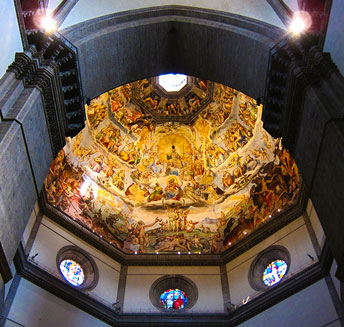The setting of Dan Brown’s latest novel, Inferno, has brought renewed attention to the Italian city of Florence. And one can hardly think of Florence without also thinking of the iconic structure that dominates the Florentine skyline, the Cathedral of Santa Maria del Fiore, otherwise known as Brunelleschi’s Dome.

The dome of Basilica di Santa Maria del Fiore in Florence. (photo: Albertus82/Flickr/Creative Commons) |
In 1418, a design competition was announced to complete Florence’s new cathedral, with specifications viewed by many as impossible to meet. The terms of the competition required that the dome must not employ the flying buttresses so commonly used to support cathedrals throughout Europe. Moreover, given the size of the structure, no scaffolding would have been strong enough to bear the weight of the dome’s 70 million pounds of masonry and brick. In essence, the massive vault would need to be constructed over thin air.
Filippo Brunelleschi, a goldsmith and clockmaker, was the unlikely winner of the design competition, and dedicated the next 28 years of his life to erecting what is still the largest masonry dome in the world, solving seemingly intractable engineering puzzles and revolutionizing the practice of architecture in the process. At 45 meters across, Brunelleschi’s Dome is more than a third larger than the diameter of the US Capitol.
A few months ago I had the opportunity to climb to the top of il Duomo, using the same interior, winding staircase used by workers nearly 600 years ago. As I gazed down into the central nave, I reflected: what makes sacred space sacred? Beyond Brunelleschi’s architectural genius, what gives this cathedral—or any architectural work—a quality of holiness? Using a category from Rudolf Otto’s classic work, The Idea of the Holy, why do we experience certain spaces as numinous?
I found clues to these questions and others in a fascinating collection of essays, entitled Constructing the Ineffable: Contemporary Sacred Architecture, which was the product of a 2007 symposium jointly convened by the Yale School of Architecture, Yale Divinity School, and the Yale Institute of Sacred Music (ISM).
Vincent Scully, Sterling Professor Emeritus of the History of Art at Yale and one of the symposium’s contributors, once described architecture as a “social art… a conversation across time” that builds on the interplay between “form and meaning and history.” If we were to expand this notion to include salvation history—the story of God’s love affair with creation—I think we begin to approach the mystery of why we experience certain spaces as numinous. Another contributor to Constructing the Ineffable, YDS’s Miroslav Volf, advances this inquiry by suggesting that architecture is “properly sacred….only as a site of sacred memory.”
With the extraordinary dynamism of the ISM, Yale is uniquely positioned to engage such questions. The presence of the ISM is one example where we can see the extraordinary power of theological education within the context of a world class research university. The ISM’s mission, after all, is to educate leaders who “foster, explore and study engagement with the sacred” through music, worship and the visual arts in the context of “Christian communities, diverse religious traditions and public life.”
The ISM is, in artistic terms, a remarkable jewel.
| Attachment | Size |
|---|---|
| 5.22 KB |